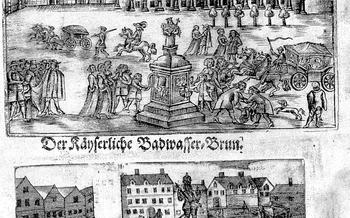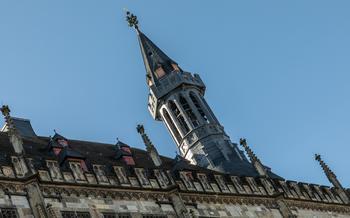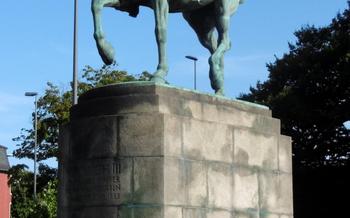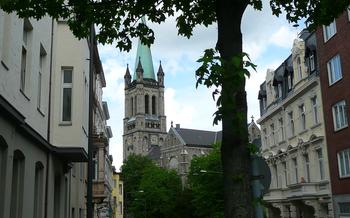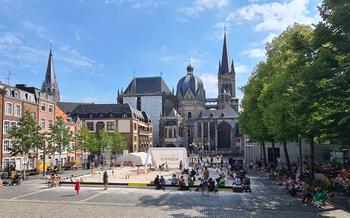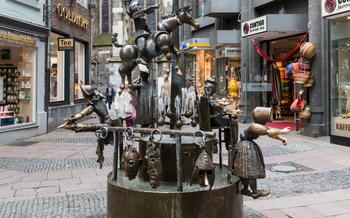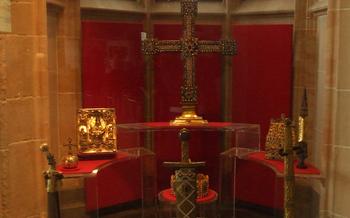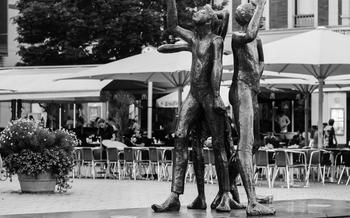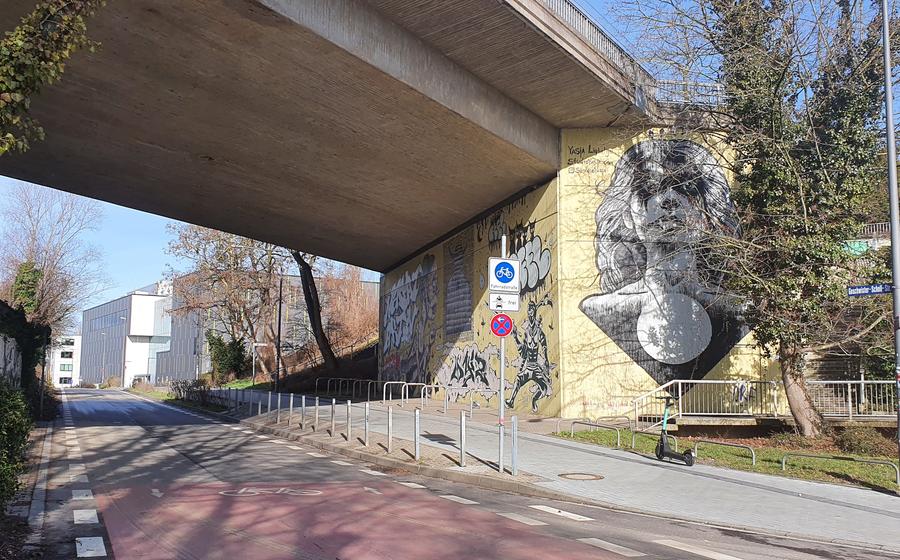
Greif Statue at the Town Hall
- Architectural Features
- Location and Accessibility
- Symbolic Meaning
- Cultural Significance
- Photo Opportunities
- Historical Context
- Local Legends
- Restoration and Preservation
- Artistic Value
- Unique Features
- Historical Tours
- Events and Festivals
- Nearby Attractions
- Insider Tip: Capture the Magic at Sunset
Architectural Features
The Greif Statue is a remarkable work of art, crafted from bronze and mounted atop a stone pedestal. It stands as a testament to the skill and artistry of medieval craftsmen. The statue portrays a mythical griffin, a creature with the head of an eagle and the body of a lion, symbolizing strength, vigilance, and courage. The griffin is depicted in intricate detail, with its feathers, muscles, and claws meticulously rendered. The statue's wings are spread wide, as if poised for flight, adding to its majestic presence. The stone pedestal complements the bronze statue, providing a sturdy base and enhancing its overall visual appeal. Together, the statue and pedestal form a harmonious ensemble that has become an iconic symbol of Aachen.
Location and Accessibility
The Greif Statue stands proudly in front of the historic Aachen Town Hall, a prominent landmark in the heart of the city center. Its central location makes it easily accessible for visitors exploring Aachen's rich heritage. The statue is part of the Aachen Cathedral complex, a UNESCO World Heritage Site renowned for its architectural splendor and historical significance. This proximity allows visitors to seamlessly combine their visit to the Greif Statue with a tour of the cathedral and other nearby attractions, creating a comprehensive and enriching experience.
Symbolic Meaning
The Greif Statue at the Town Hall in Aachen is not merely an artistic masterpiece but also a potent symbol deeply embedded in the city's identity and heritage. It represents strength, courage, and vigilance, embodying the indomitable spirit of Aachen and its citizens. As the guardian of the city's treasury and archives, the statue stands as a testament to Aachen's rich history and the preservation of its valuable treasures. Moreover, the griffin, with its majestic presence, symbolizes the city's pride in its imperial past and its enduring status as a symbol of unity and independence. Each intricate detail of the statue whispers tales of Aachen's triumphs and struggles, making it a living testament to the city's enduring legacy.
Cultural Significance
The Greif Statue is not merely an architectural marvel but also holds profound cultural significance for the city of Aachen. It has become an integral part of the city's identity, embodying its rich history, cultural heritage, and civic pride. The statue is deeply embedded in the city's folklore and legends, featuring prominently in local festivals and events. During the annual Aachen Charlemagne Prize ceremony, the statue serves as a backdrop for the prestigious award presentation, further emphasizing its symbolic importance. The Greif Statue is a testament to Aachen's cultural vibrancy and its enduring connection to its past, serving as a source of inspiration and pride for its citizens.
Photo Opportunities
The Greif Statue provides a picturesque backdrop for capturing memorable tourist photos. With its imposing presence and intricate details, the statue offers a unique opportunity to capture the grandeur of medieval craftsmanship. Visitors can frame the statue against the backdrop of the historic Aachen Town Hall, creating a visually stunning composition. The surrounding architecture, with its Gothic spires and ornate facades, adds to the charm and visual appeal of the location. Shareable moments on social media platforms can help spread the word about this hidden gem and inspire others to explore the rich cultural heritage of Aachen.
Historical Context
The Greif Statue was erected in 1349 to mark a significant milestone in Aachen's history: its independence from the Duchy of Limburg. This monumental event marked a turning point for the city, as it gained autonomy and the status of a free imperial city within the Holy Roman Empire. The statue was commissioned by the city council as a symbol of this newfound freedom and independence. It replaced an earlier wooden statue that had been destroyed by fire, demonstrating the city's commitment to preserving its heritage and identity.
Over the centuries, the Greif Statue has undergone several restorations and renovations. In the 19th and 20th centuries, extensive restoration work was carried out to preserve the statue's historical integrity and artistic value. These efforts involved repairing damage, cleaning the bronze surface, and reinforcing the structure. Today, the statue stands as a testament to Aachen's rich history, resilience, and enduring legacy as an independent city.
Local Legends
The Greif Statue is deeply intertwined with the rich tapestry of Aachen's folklore and legends. One of the most captivating tales is the legend of the four griffins guarding the city's treasure. According to this myth, four griffins were entrusted with the task of protecting Aachen's wealth, hidden in a secret vault deep beneath the city. Each griffin possessed unique powers, symbolizing strength, courage, wisdom, and vigilance. They stood guard, ensuring that no harm would befall the city's precious treasures.
Over time, stories and myths about the griffins were passed down through generations, becoming an integral part of Aachen's cultural heritage. Locals believed that the griffins possessed magical abilities, protecting the city from harm and misfortune. These legends added an aura of mystery and wonder to the Greif Statue, making it a symbol of Aachen's rich history and imagination.
Restoration and Preservation
The Greif Statue has undergone several restoration and preservation efforts over the centuries to maintain its historical integrity and longevity. In the 19th century, the statue was extensively restored to address wear and tear, corrosion, and damage caused by weathering. Skilled craftsmen carefully repaired and replaced damaged sections, ensuring that the statue's original form and details were preserved. In the 20th century, further restoration work was undertaken, focusing on cleaning, stabilizing, and protecting the statue's surface. Ongoing maintenance and monitoring are carried out to identify and address any potential issues, ensuring that the Greif Statue continues to stand as a proud symbol of Aachen's rich history and cultural heritage for generations to come.
Artistic Value
The Greif Statue is widely recognized for its artistic value and is considered a masterpiece of Gothic art. It exemplifies the skill and creativity of medieval craftsmen, showcasing intricate details, expressive features, and a harmonious composition. The statue's proportions and posture convey a sense of strength and majesty, while the intricate carvings on its wings, body, and pedestal add depth and visual interest. The statue's overall design reflects the artistic and cultural influences of the period, blending classical and Gothic elements into a unique and captivating work of art. Its artistic significance lies in its ability to transcend its historical and symbolic value and stand as a testament to the creative genius of the era.
Unique Features
The Greif Statue stands out for its unique characteristics that set it apart from other statues. Its age, estimated to be around 700 years, makes it one of the oldest surviving bronze statues in Germany. This remarkable longevity adds to its historical significance and makes it a valuable artifact.
Moreover, the statue's depiction of a griffin, a mythical creature with the head of an eagle and the body of a lion, is uncommon in statues. Griffins, often associated with strength, vigilance, and wisdom, were popular motifs in medieval art. The Greif Statue's griffin symbolizes Aachen's resilience, independence, and rich cultural heritage.
Additionally, the statue's status as a symbol of Aachen's independence as a free imperial city is noteworthy. In the Middle Ages, free imperial cities were directly subordinate to the Holy Roman Emperor and enjoyed considerable autonomy. The Greif Statue served as a reminder of Aachen's privileged status and its freedom from external rule.
Historical Tours
Discover the rich history and significance of the Greif Statue by joining a guided walking tour of Aachen's Old Town. Led by knowledgeable local guides, these tours offer an immersive experience, delving into the tales and legends surrounding the statue and its role in shaping the city's identity.
As you stroll through the charming streets, you'll learn about the statue's creation in 1349, its symbolic meaning as a guardian of the city's rights and privileges, and its association with Charlemagne and the Holy Roman Empire. The guides will point out other landmarks and attractions nearby, providing a comprehensive overview of Aachen's rich history and cultural heritage.
By participating in a guided tour, you'll gain a deeper understanding and appreciation for the Greif Statue and its place in Aachen's story. Immerse yourself in the city's past as you explore the hidden gems and uncover the secrets of this remarkable statue.
Events and Festivals
The Greif Statue is not merely a historical landmark but also an integral part of Aachen's vibrant cultural scene. During special events and festivals held in the city, the statue becomes a focal point for celebrations and cultural performances. One such event is the annual Aachen Charlemagne Prize ceremony, where the statue stands as a silent witness to the prestigious award ceremony honoring individuals who have made significant contributions to European unity.
During the festive Christmas season, the Greif Statue is adorned with festive lights and decorations, creating a magical atmosphere in the city center. The statue becomes a popular spot for locals and tourists alike to gather, sing carols, and celebrate the holiday spirit.
Whether it's a music festival, a cultural fair, or a traditional market, the Greif Statue serves as a backdrop for a variety of events that showcase Aachen's rich history, cultural diversity, and festive spirit.
Nearby Attractions
In the immediate vicinity of the Greif Statue, you can discover an array of captivating landmarks that further enrich your Aachen experience. The majestic Aachen Cathedral, a UNESCO World Heritage Site, stands as a testament to the city's imperial past. Its awe-inspiring architecture, intricate carvings, and stained-glass windows are sure to leave you spellbound. Just a stone's throw away, the historic Aachen Town Hall, with its ornate facade and opulent interior, serves as the seat of local government. Its rich history and architectural splendor make it a must-visit for any history buff.
Stroll a little further, and you'll encounter the Elisenbrunnen, a graceful fountain that graces the city center. This elegant structure, adorned with intricate carvings and topped with a majestic dome, is a popular gathering spot for locals and tourists alike. As you wander through Aachen's charming streets, be sure to savor the vibrant atmosphere and discover hidden gems around every corner.
Insider Tip: Capture the Magic at Sunset
For a truly unforgettable experience, visit the Greif Statue at sunset. As the sun dips below the horizon, the sky transforms into a canvas of golden hues, casting a warm and ethereal glow on the statue and the surrounding buildings. This magical light enhances the statue's intricate details and creates a breathtaking backdrop for your photos. Capture this special moment and share it with the world, showcasing the beauty of Aachen in a unique and captivating way.
